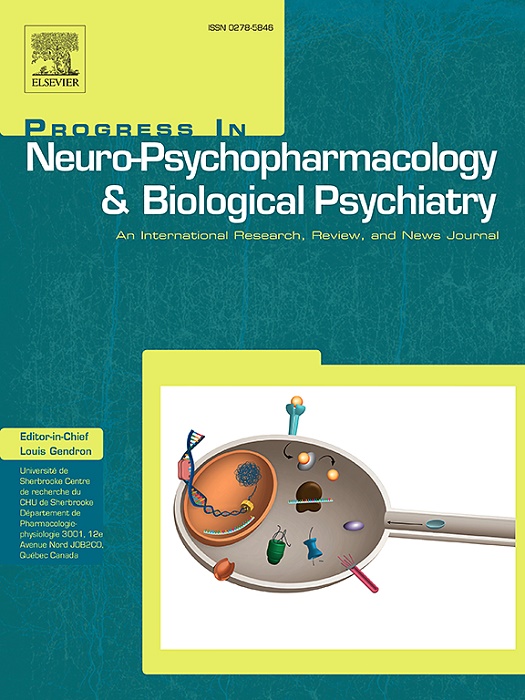不同性别和年龄组中基于神经影像学的重度抑郁症亚型:与性激素动态的潜在联系
IF 3.9
2区 医学
Q1 CLINICAL NEUROLOGY
Progress in Neuro-Psychopharmacology & Biological Psychiatry
Pub Date : 2025-09-11
DOI:10.1016/j.pnpbp.2025.111497
引用次数: 0
摘要
功能连接(FC)特征是增强重度抑郁症(MDD)诊断和治疗的有效生物标志物。虽然性激素在MDD发病机制中起着至关重要的作用,但与性激素波动有关的神经影像学特征在MDD鉴定中仍未得到充分的探索。方法采用7316名性激素和抑郁评估参与者的数据集,分析不同年龄和性别群体的抑郁与性激素的关系。此外,我们利用包含753例MDD患者的REST-meta-MDD数据集,建立了基于多卷积网络和注意力池的新型图分类框架,以识别与性激素动态相关的MDD亚型。结果smdd个体的雌激素水平高于健康对照组(HC)。女性重度抑郁症患者的睾丸激素水平也高于HC。年轻和中年重度抑郁症患者的抑郁症状差异主要见于女性,而在男性中未发现明显的年龄相关差异。我们的新方法对中青年重度抑郁症患者的分类准确率达到75%以上。鉴别特征主要存在于男性的感觉运动网络和女性的扣带-眼窝网络中。结论这些发现表明,性别和年龄特异性FCs在识别MDD亚型中起关键作用,尤其是对于女性患者。与终生性激素波动的间接关联表明,未来的研究应该调查性激素在年龄-性别维度上的影响,而不仅仅是比较成像差异。因此,这种方法可以促进抑郁症的个性化诊断和临床干预本文章由计算机程序翻译,如有差异,请以英文原文为准。
Neuroimaging-based subtypes of major depressive disorder in different sex and age groups: a potential link to sex hormone dynamics
Background
Functional connectivity (FC) features serve as effective biomarkers to enhance the diagnostic and treatment of major depressive disorder (MDD). While sex hormones play a crucial role in MDD pathogenesis, neuroimaging signatures specifically linked to sex hormone fluctuations remain critically underexplored for MDD identification.
Methods
A dataset including 7316 participants with sex hormones and depression assessment was used to analyzed the relationships between depression and sex hormones across age and sex groups. Additionally, employing REST-meta-MDD dataset including 753 MDD patients, we established a novel graph classification framework based on multi-convolution network and attention pooling to identify MDD subtypes related to sex hormone dynamics
Results
MDD individuals of both sexes showed elevated estrogen levels than healthy controls (HC). Female MDD individuals also had higher testosterone levels than HC. Depressive symptoms differences between young and middle-aged MDD individuals were predominantly observed in females, whereas no significant age-related variations were detected in males. Our novel method achieved over 75 % accuracy in classifying young and middle-aged MDD patients. Discriminative features were mainly in the sensorimotor network for males and the cingulo-opercular network for females
Conclusion
These findings revealed that sex- and age-specific FCs were critically in identifying MDD subtypes, especially for female patients. The indirect association with lifelong sex hormone fluctuation suggests that future research should investigate sex hormone effects across age-sex dimensions rather than merely comparing imaging differences. Thus, this approach could advance personalized MDD diagnosis and clinical interventions
求助全文
通过发布文献求助,成功后即可免费获取论文全文。
去求助
来源期刊
CiteScore
12.00
自引率
1.80%
发文量
153
审稿时长
56 days
期刊介绍:
Progress in Neuro-Psychopharmacology & Biological Psychiatry is an international and multidisciplinary journal which aims to ensure the rapid publication of authoritative reviews and research papers dealing with experimental and clinical aspects of neuro-psychopharmacology and biological psychiatry. Issues of the journal are regularly devoted wholly in or in part to a topical subject.
Progress in Neuro-Psychopharmacology & Biological Psychiatry does not publish work on the actions of biological extracts unless the pharmacological active molecular substrate and/or specific receptor binding properties of the extract compounds are elucidated.

 求助内容:
求助内容: 应助结果提醒方式:
应助结果提醒方式:


